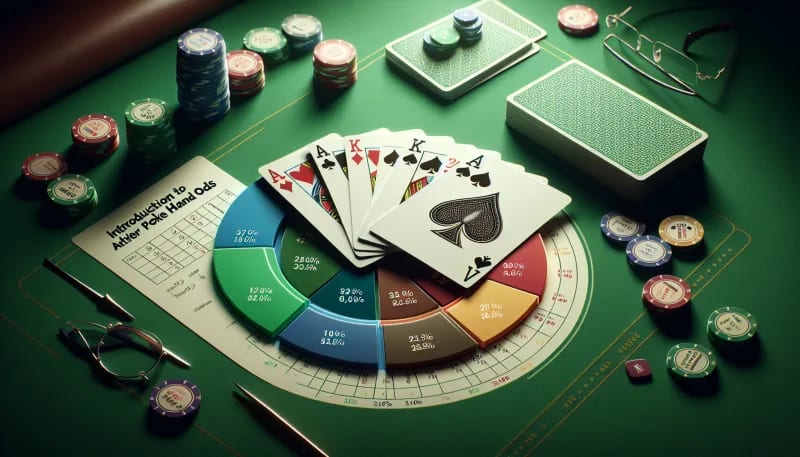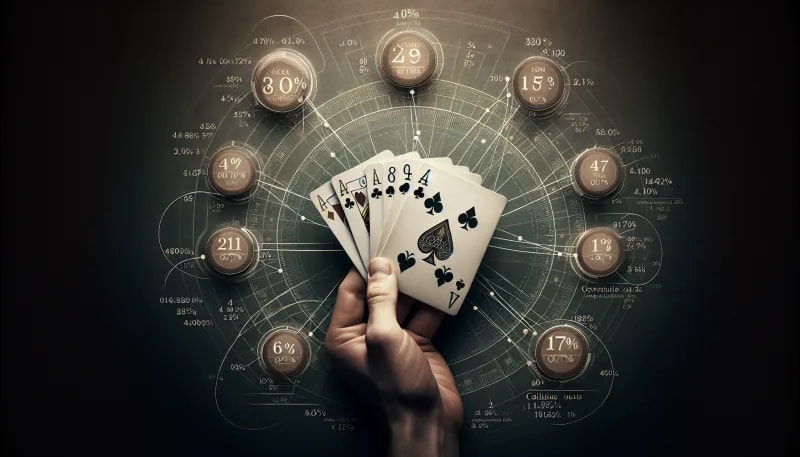Mastering Poker Hand Odds: Boost Your Winning Chances
Introduction to Poker Hand Odds
Guesswork has no place at a poker table, does it? I think we can all agree that relying on pure chance is a novice's strategy. Here's where understanding poker hand odds comes into play, an essential tool for anyone's mental toolkit, whether you're just stacking your first chips or you're the veteran eyeing the big pot.
Consider this: every decision you make at the poker table, from calling to betting to folding, hinges on the odds. They're the mathematical backbone of the game, telling you the likelihood of holding a winning hand. Don't you want to play with confidence? Knowing these odds boosts your game to a level of calculated risks rather than blind gambles.
Poker hand odds, simply put, enable you to gauge the probability of winning with the cards you've been dealt. For the beginner, it's the sharpening stone that hones your instincts. And for the seasoned pro, it's the compass that navigates through bluffs and tells to secure victories. The odds give you that keen insight, making it possible to outplay luck itself.
Indeed, every hand you're dealt begs the question: To play or not to play? Understanding hand odds serves as your guideline, dictating your actions with statistical support rather than whimsical hope. As you tune in to this aspect, you'll notice patterns, recognize opportunities, and make strategic choices that increase your chances of winning. Isn't that the ultimate goal?
Armed with this knowledge, you'll be prepared to delve into the next part: The Basics of Probability in Poker. It's there that we'll break down how probabilities work in the game of poker, laying the groundwork for the more intricate strategies that can elevate your play. The journey to mastering poker starts with knowledge, so let's shuffle up and deal.
The Basics of Probability in Poker
Building on our 'Introduction to Poker Hand Odds', let's delve into the crux of poker – probability. Probability is the backbone of poker strategy and understanding it is key to making smart decisions. I cannot stress enough how vital this concept is; it’s what dictates your every move at the felt.
Ever wondered why we play the way we do? It's the odds. They are the cold, hard math behind the drama of a well-timed bluff or the sigh-inducing fold. Poker is a game of incomplete information and randomness. But don’t be fooled. It’s not all luck. I use probability to gauge the likelihood of potential outcomes and to inform the decisions I make during each hand.
Knowing the number of cards in a deck (52, minus any you have seen), I can calculate the chance of drawing a specific card. For instance, the probability of getting an Ace on the next draw when two are already visible is 2 out of 50. That's a 4% chance and not something I'd bet the farm on.
Randomness and poker might seem like old pals, but don’t let it intimidate you. Why? Because probability helps us bring order to the chaos. It answers questions like, “What are the odds of completing my flush on the river?” or “Should I call this bet based on my hand's potential?”
As I assess the likelihood of drawing different hands, I'm weighing both the risk and the reward. The chance of hitting a gutshot straight draw, about 16% after the flop, isn't great. Knowing this, I'm more cautious about pouring money into the pot.
So, understanding fundamental probability concepts isn't just helpful — it's essential. It’s the difference between a guess and an educated decision.
Up next, you'll find 'Poker Hand Rankings Overview', which builds on this probability groundwork. After all, what good is knowing the odds if you're not sure which hands beat what?
Poker Hand Rankings Overview
Alright, let's dive straight into the heart of poker – the hand rankings. Remember how we chatted about probabilities in the previous section? Well, knowing your hand rankings is the key to understanding those odds. Can you really play effectively if you’re unsure whether a straight beats a flush? Spoiler: It doesn’t.
So, what's at the top of this all-important list? The Royal Flush. It's the ace-high straight flush, and it's as royal as it sounds. Think ace through ten, all the same suit. Getting one of these is like hitting the jackpot – because you're unbeatable when you do.
Next up is the Straight Flush. Any five consecutive suited cards that don't make it to the Royal level. If you snag one, you're sitting pretty; they're rare and powerful.
Now for the Four of a Kind. Got four aces? Nice! Any four numerically matching cards will do, but higher is always better.
The Full House follows. It's a pair plus a three of a kind in the same hand. Sounds cozy, right? Well, it's strong enough to make opponents uncomfortable.
A rainbow spread of cards in sequence? That's a Straight. No need for them to match suits. Just line them up, five in a row.
A Flush flushes away any hand without similar stature. All you need? Five cards, same suit, any order.
Three of a Kind is self-explanatory. Three cards, same number or face, like three jacks looking back at you.
Two pair? That's simply called Two Pair. It's a double dose of pair power.
A single pair might not sound exciting but it's the One Pair – often a game changer.
And on the bottom? High Card. It’s just what it sounds like, sometimes all you have is a high card. But remember, in poker, even the underdog can bite.
Now, you're equipped with the essentials. Know these like the back of your hand, and you're set to tackle those hand odds in the next section. Ready to calculate some poker hand odds? Let’s see if we can use this knowledge to bring even more strategy to our game.
Calculating Poker Hand Odds
Just got the hang of hand rankings? Great. Now, let's talk strategy. How do you actually use that knowledge at the table? Well, it all comes down to working the numbers—specifically, hand odds.
Outs are the cornerstone here. Picture this: you're holding two hearts, and two more hit the flop. You're eyeing that flush. But how likely is it? To figure it out, count your outs—the cards left in the deck that will complete your hand. In this case, you’ve got 9 more hearts out there.
So what do you do with these outs? Simple math. There are 52 cards in a deck, right? Minus your 2, minus the 3 on the board. That leaves 47 unseen cards. With 9 outs, your odds of hitting a heart on the turn are 9/47. But what about the river too? Double the outs, add two. That's the quick way. With me so far?
Take our example: 9 outs, double to 18, plus 2 makes 20. Now, roughly, you've got a 20 in 47 chance, or a bit over 40%, to see that flush by the river.
Knowing these odds does more than build hope; it guides your betting. Is your opponent betting big? Do the odds justify calling? Is the potential payout worth the risk? Thinking this way is key to smart, odds-driven play.
Next, you'll want to compare these odds to the pot odds, but that's a tale for another time. For now, let's shift gears to the Common Poker Hand Odds you might encounter. Ever wonder what the chances are of landing that elusive straight flush? Hold tight, because I'm going to break down the likelihood of these dream scenarios hitting your hand.
Common Poker Hand Odds
After exploring how to calculate poker hand odds, let's dive into some typical probabilities you'll face at the table. Ever wonder what the odds are of being dealt a certain hand? Let's get to it.
Pocket Pairs - Expect a pocket pair once every 17 hands, as the chance sits around 6%. It's not as rare as a comet, but you won't see them every orbit.
A Flush Draw after the flop? You're looking at around a 1 in 3 chance, assuming you’re holding two suited cards. When the chips are down, that's a gamble many of us are willing to take.
Making that Flush by the river, though, tapers down to about a 35% chance if you have four suited cards after the flop. It's a coin flip that's slightly biased in your favor.
What about Straights? If you're holding two connected cards, you've got roughly a 10% shot to hit a straight by the river. It's a road less traveled, but the payoff can be scenic.
Straight Draws get a touch more complex. An open-ended draw after the flop offers about a 32% chance to hit by the river. But a gutshot? It's more like a shot in the dark at 16%.
Now, royal flushes and quads might be the holy grail, but they’re the stuff of poker legend for a reason. You've got a meager 0.000154% and 0.024% chance, respectively. Are you feeling lucky?
What's this mean for you? Solid decision-making relies on understanding these numbers. Knowing the odds, can you afford to call that next bet?
We've broken down the basics, but how do these odds shift when the game dynamic changes? Stay tuned as we jump into 'The Impact of Game Variables on Hand Odds' and dissect how things like player behavior and table position affect the stats you've just learned.
The Impact of Game Variables on Hand Odds
So we've covered common poker hand odds, but how do these fluctuate with game variables? Trust me, they can change quite a bit. Consider this: Are your pocket aces as strong in a ten-handed game as they are head-to-head? Not exactly. The number of players drastically sways the strength of your hand.
In Texas Hold'em, for example, the odds of winning with certain hands drop as more players enter the pot. Head-to-head, pocket aces are a heavy favorite, but in a full ring game, their dominance diminishes. The same holds for suited connectors or small pairs – hands that can flop big but also easily become underdogs in multi-way pots.
Switch to Omaha, and the story twists even more. Each player has four hole cards, creating a wider range of possible hands. Here, the nuts—or the best possible hand—changes frequently, and holding on to what was once a strong hand can be a costly mistake. Odds here are a slippery slope; they aren't just about math, they're about potential.
No-limit and limit games throw another wrench in the works. The ability to bet any amount in no-limit means you can pressure opponents differently, affecting the implied odds of your hands. How will the game format influence the way you play your starting hands? Always an important question.
Adapting your odds knowledge to the game variant and the number of opponents is crucial. Player tendencies, stack sizes, and betting patterns merge with hand odds to guide your decisions. But remember, it's not just about the cards; it's about the situation.
As we move on to 'Real-World Applications: Using Hand Odds at the Table,' keep these variables in mind. In a live setting, crunching numbers quickly matters, but so does flexibility. Odds are static, yet the game of poker is anything but. The best players can feel the pulse of the table and adjust on the fly. Let's dive deeper into that, shall we?
Real-World Applications: Using Hand Odds at the Table
So, you've wrapped your head around how game variables impact hand odds. Now, let's put that intel to action. Can you handle the heat of real-time calculations?
Picture this: You're sitting at the table and you're dealt a flush draw after the flop. There's a pot worth chasing, but should you? You've got nine outs with two cards to come. Quickly, the old 4-2 rule comes in handy. Multiplying your outs (9) by 4 gives you an approximate chance of hitting that flush by the river—36%. It's a substantial number, but is the pot giving you the right price?
Consider the pot odds. If the pot is $100 and the bet to you is $20, you're getting 5-to-1 on your money. That's 20%—much lower than your hand odds. In this case, the math says 'call', and you should listen.
Now, what about when the river is all that's left? Slash your outs by half using the 2 rule—giving you roughly 18%. The decision becomes trickier. But here's a golden nugget: always be adaptable. If the pot odds aren't aligning as hands progress, reconsider your stance. Maybe that river call isn't worth the risk with diminished odds.
Remember that every hand is a fresh puzzle. You're constantly ingesting new data, reshuffling those mental cards. Are there more players in the hand? Did someone raise pre-flop suggesting a strong hand? It all affects those odds and our decisions.
Don't forget that practice sharpens instinct. When you’re familiar with common scenarios, your brain does the math faster—almost reflexively. That's how you'll stay sharp and keep opponents on their toes.
Stay tuned, we'll dive deeper in the next piece, 'Advanced Considerations and Poker Math', where your sharpened skills meet the Everest of poker strategy. A realm where those willing to transcend the basics see their game—and their stack—soar.
Advanced Considerations and Poker Math
Building on our prior discussion of using hand odds at the table, let's now sink our teeth into the meatier aspects of poker math. I can tell you first-hand – mastering these concepts is a game-changer.
Ever faced a bet and wondered, "Should I really call?" This is where implied odds come into play. Implied odds consider not just the money already in the pot, but also the additional amount you can win on later streets. It's a matter of looking ahead, evaluating potential outcomes and payoffs beyond the immediate scenario.
Now, ponder this: How frequently must you win when calling a bet to break even? The answer lies in understanding pot odds. Simply put, they are the ratio of the current size of the pot to the size of the bet you must call. It's crucial because if your hand odds of winning are better than your pot odds to call, you're effectively making a profitable decision.
But we're not done yet. Let's get down to the brass tacks with expected value (EV). EV is the cornerstone of any seasoned poker strategy. It’s the average amount of big bets a hand will win or lose. A positive EV means profit over the long haul, whereas a negative EV spells trouble. Consider EV as your North Star, guiding every action you take at the felt.
So, are you ready to calculate some EV and make decisions that rake in those chips over time? Remember, a poker pro doesn't play hands; they play edges. And it’s the understanding of pot odds, implied odds, and EV that sharpens these edges.
Our excursion into advanced poker math doesn't just elevate your game; it's your ticket to outplaying the competition when the stakes are high. It's about transforming good plays into great ones, and turning those close decisions into clear-cut victories.
Ready to experiment with these concepts at your next session? Trust me, the math pays off.








